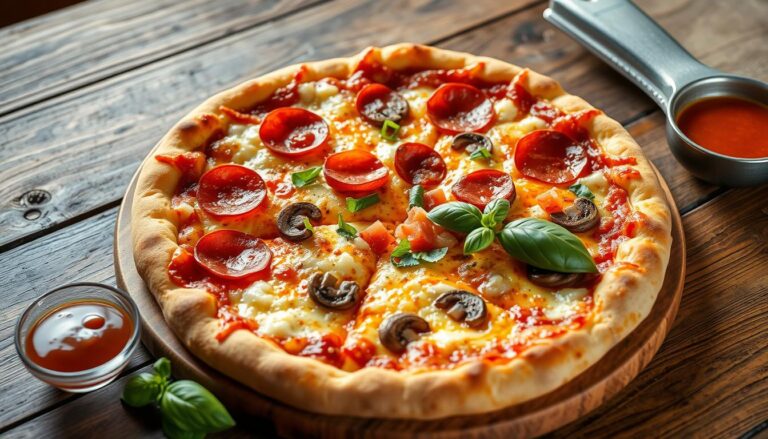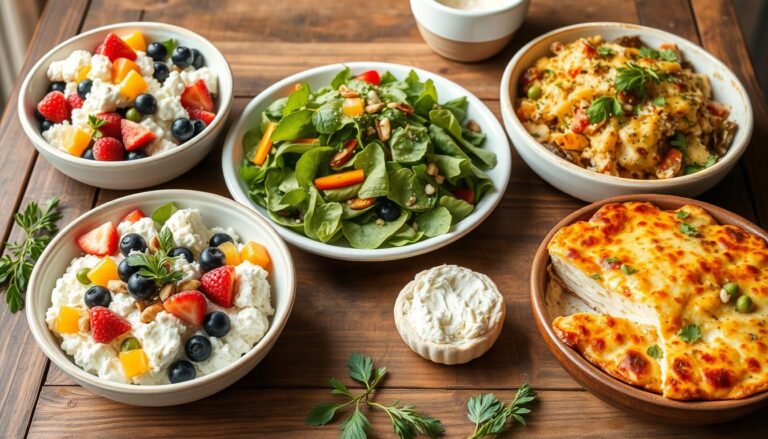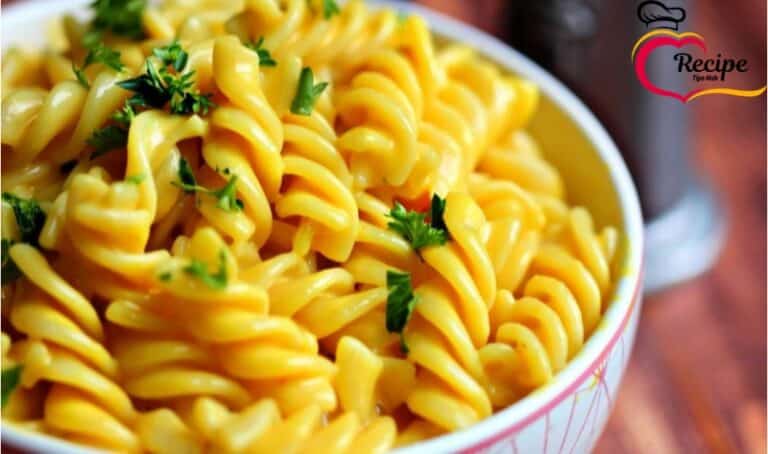Explore the tasty world of pizza pie, where endless flavor combinations await. We’ll show you how to make the perfect pizza dough. You’ll learn about new sauce options and how to mix sweet and savory toppings.
Discover the best cheeses for pizza and the differences between wood-fired and home ovens. We’ll also cover regional pizza styles that delight people everywhere. Get ready for recipes that turn pizza into a breakfast or dessert treat.
Key Takeaways
- Discover the secrets to creating the perfect pizza dough, from ingredient selection to proofing and shaping techniques.
- Explore a world of sauce possibilities beyond the traditional tomato, adding depth and complexity to your pizza creations.
- Learn the art of balancing sweet and savory toppings to create a harmonious flavor profile on your pizza pie.
- Understand the differences between wood-fired and home oven baking, and how to achieve the desired crust and texture.
- Dive into the distinct regional pizza styles, from the iconic New York-style thin crust to the decadent Chicago deep dish.
Mastering the Perfect Pizza Dough
Making a great pizza dough is key to delicious pizza pies. It’s all about picking the right pizza dough ingredients and knowing how to proof and shape the dough. These steps are crucial for improving your pizza making skills.
Ingredients and Techniques
The basic pizza dough ingredients are flour, yeast, water, salt, and a bit of olive oil. The way you mix these can greatly affect the dough. Try different flours like all-purpose, bread, or whole wheat to see what you like best.
Getting the dough right means kneading and mixing well. This helps develop the gluten and makes the dough easy to work with. So, don’t hesitate to knead it until it’s smooth and elastic.
Proofing and Shaping Dough
After making the dough, let it proof. This lets the yeast do its job and gives the dough its airy texture. Keep an eye on the proofing time and temperature for the best results. When shaping, handle the dough gently to keep those air pockets intact.
Shaping the dough takes practice, but with time, you’ll get the hang of it. Try using a rolling pin or stretching it by hand to see what works for you.
“The secret to a perfect pizza dough lies in the balance of ingredients and the care taken during the proofing and shaping process.”
| Ingredient | Recommended Amount |
|---|---|
| Flour | 3 cups (375g) |
| Yeast | 1 teaspoon (3g) |
| Water | 1 1/4 cups (295ml) |
| Salt | 1 teaspoon (5g) |
| Olive Oil | 1 tablespoon (15ml) |
Exploring Sauces Beyond Tomato
While tomato sauce is a classic in pizza, many are now trying new pizza sauce options. These alternative sauces bring unique flavor combinations. They can take your pizza to new levels.
A creamy garlic-based sauce is a great choice. Mix garlic, olive oil, and a bit of cream for a rich, savory base. It goes well with grilled chicken, roasted veggies, and fresh herbs.
For a fresh taste, try a vibrant pesto sauce. Combine basil, pine nuts, Parmesan, and olive oil for a lively, herbaceous flavor. It’s perfect with diced tomatoes, artichoke hearts, and crumbled feta.
- Garlic-based cream sauce
- Pesto sauce
- BBQ sauce
- Alfredo sauce
- Olive oil and herb sauce
Feeling adventurous? A tangy BBQ sauce or a creamy Alfredo sauce can be great. Use BBQ sauce with grilled chicken, caramelized onions, and fresh cilantro. Or, pair Alfredo with sautéed mushrooms, spinach, and Parmesan.
The world of pizza sauce is yours to explore. Try different flavor combinations and find new tastes. Your family and friends will love it.
Pizza Pie: Combining Flavors in One Dish
The secret to a great pizza is finding the right mix of flavors and textures. Learn how to blend sweet and savory tastes. Also, try new pizza toppings to make your pizza stand out.
Balancing Sweet and Savory
Creating a sweet and savory pizza takes skill. Mix sweet fruits or caramelized onions with meats or cheeses for a great taste. The goal is to find flavor combinations that work well together.
Unique Topping Combinations
Don’t stick to the usual pizza toppings. Try new vegetables or proteins for a unique pizza. Mix things like roasted butternut squash with crumbled feta, or grilled pineapple with spicy Italian sausage.
“The beauty of pizza lies in its ability to transform simple ingredients into a symphony of flavors.”
With sweet and savory flavor combinations, you can make pizzas that wow your guests. They’ll want more.
The Art of Cheese Selection
Cheese is key to making the perfect pizza. From classic mozzarella to bold parmesan, the right cheese can change your pizza game. We’ll dive into fresh and aged cheeses, showing how they boost your pizza’s taste.
Fresh vs. Aged Cheeses
For pizza cheese, you have fresh and aged types. Fresh cheeses like mozzarella and ricotta are soft, creamy, and mild. They melt well, creating a gooey layer that’s perfect for pizza. Aged cheeses like parmesan and asiago have deeper flavors. They add a rich, nutty taste to your pizza.
| Fresh Cheese | Aged Cheese |
|---|---|
| Mozzarella | Parmesan |
| Ricotta | Asiago |
| Burrata | Aged Cheddar |
Think about mixing fresh and aged cheeses on your pizza. Fresh cheese melts well, while aged cheese adds a sharp taste. Together, they create a great flavor mix.
“The perfect pizza is a symphony of flavors, with the cheese being the conductor that brings it all together.” – Chef Dominic Ansel
Try different pizza cheese mixes to find what you like best. This will make your pizza toppings work well together.
Wood-Fired Oven vs. Home Oven
Choosing the right oven is key to making the perfect pizza. Wood-fired ovens and home ovens have their own benefits. These differences can change how your pizza turns out.
Wood-fired ovens are great because they heat evenly and get very hot, up to 900°F. This makes your pizza crust crisp and charred, just like authentic wood-fired pizzas. The high heat also gives your pizza a smoky taste that home ovens can’t match.
Home ovens are easier to use and are perfect for most cooks at home. They don’t get as hot as wood-fired ovens but can still make tasty pizza. With the right dough, a pizza stone or steel, and watching the temperature, you can get a great crust.
| Wood-Fired Oven | Home Oven |
|---|---|
| Intense, even heat (up to 900°F) | Convenient and accessible |
| Crisp, charred crust | Requires specific baking techniques |
| Smoky flavor | Limited temperature range |
Choosing between a wood-fired oven and a home oven depends on what you like, your budget, and the pizza you want to make. Both can make great pizza with the right skills and practice.
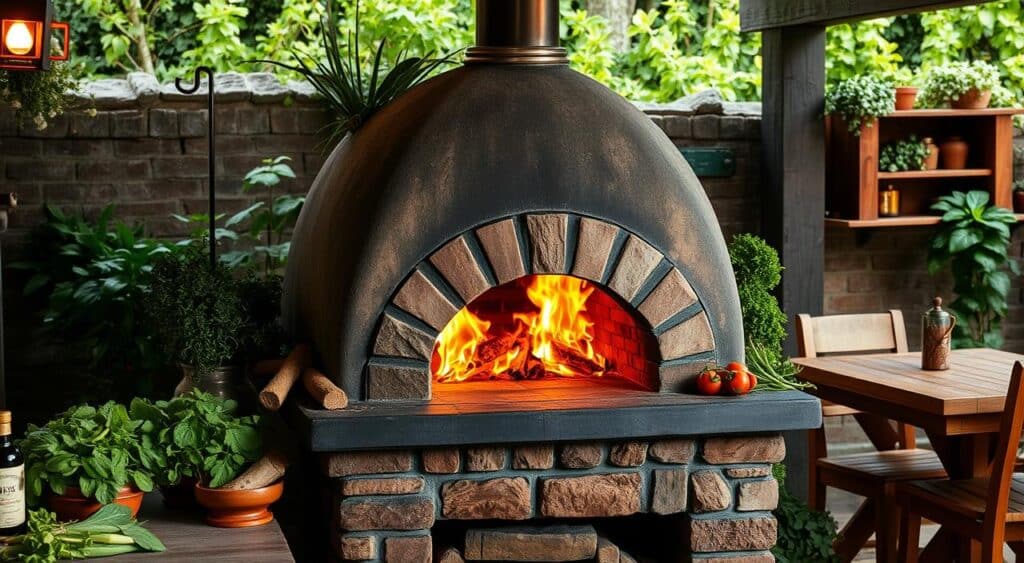
Regional Pizza Styles Explored
The art of pizza-making has grown into many regional styles, each with its own unique traits. Let’s look at the exciting features of New York-style thin crust and Chicago deep dish pizza.
New York-Style Thin Crust
New York-style thin crust pizza comes from the busy streets of New York City. It’s famous for its crisp, foldable base and lots of toppings. The dough is thin and hand-tossed, then baked to a perfect crunch.
This lets the tomato sauce and fresh mozzarella cheese flavors stand out. The thin crust contrasts well with the high-quality toppings. It makes each slice a perfect mix of textures and tastes.
Chicago Deep Dish
Chicago deep dish pizza has a thick, buttery crust that holds a lot of toppings. This style started in Chicago and has a big layer of tomato sauce seasoned with herbs and spices. Then, it’s topped with a lot of mozzarella cheese.
This deep dish design lets you put many toppings on, like savory sausage or fresh veggies. All these toppings are covered in a crispy crust.
Whether you like the crisp, foldable slices of New York-style or the rich, deep-dish flavors of Chicago, there’s a lot to try. Each style shows the creativity and love of pizza-makers. They keep making this favorite dish even better.
Pizza Party: Serving and Presentation Ideas
Hosting a pizza party is fun and exciting. The real magic happens when you serve and present your pizzas. Creative slicing and stunning garnishes can make your party unforgettable.
Innovative Slicing Techniques
Don’t stick to the usual triangular slices. Try cutting your pizza into squares, rectangles, or circles for a unique look. This adds a fun and elegant touch. Diagonal or zig-zag cuts can also make your pizza stand out.
Plating and Garnishing
Make your pizza look amazing by how you plate and garnish it. Arrange the slices in a pretty pattern, like a circle or a fan, to show off the colors and flavors. Add fresh herbs, a bit of flavored oil, or grated cheese for extra elegance.
How you serve your pizza can really make the meal special. With creative cuts and careful plating, your pizza party will be a hit. It will feel like a real celebration.
Innovative Pizza Pie Recipes
Try new things with the pizza pie and go beyond the usual tomato sauce and cheese. Learn to make breakfast and dessert pizzas that are exciting any time of day.
Breakfast Pizza Pie
Begin your day with a fun twist on traditional pizza. Make a breakfast pizza with a soft crust, scrambled eggs, and bacon or sausage. Add your favorite toppings like mushrooms, bell peppers, and caramelized onions. Finish with shredded cheddar or mozzarella cheese for a tasty morning meal.
Dessert Pizza Pie
Indulge in a sweet dessert pizza pie. Use a crust like a cookie and add fruits like apples, pears, or berries. Drizzle with a sweet glaze or add a crumble topping for a special dessert. Make it even better with whipped cream or ice cream.
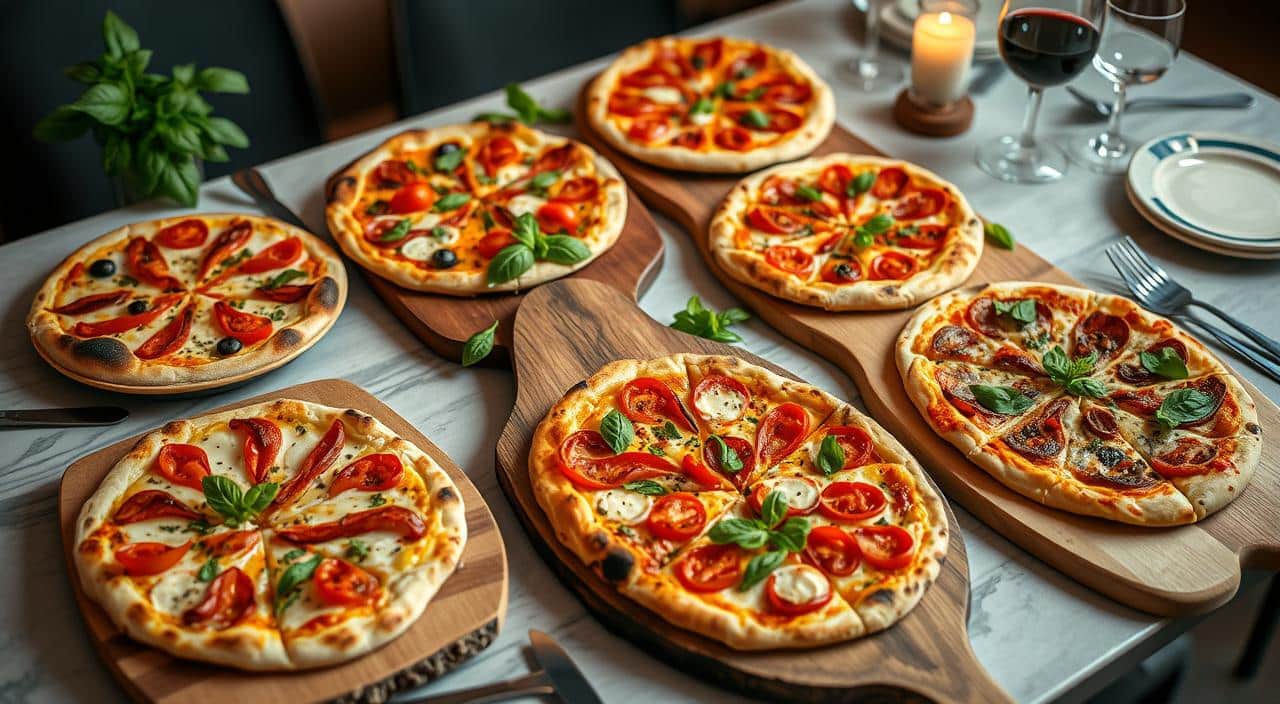
Perfect Pizza Dough & Sauce Combinations
Ingredients
- 3 cups (375g) Flour
- 1 tsp (3g) Yeast
- 1 1/4 cups (295ml) Water
- 1 tsp (5g) Salt
- 1 tbsp (15ml) Olive Oil
Instructions
- Mix Ingredients Combine flour, yeast, water, salt, and olive oil in a bowl.
- Knead Dough Knead the dough until smooth and elastic (about 10 minutes).
- Proof Dough Let the dough rest for 1 hour in a warm place until doubled in size.
- Shape the Dough Gently shape the dough by hand or use a rolling pin for your desired thickness.
- Bake the Pizza Preheat oven to 500°F (260°C). Add toppings and bake for 10 minutes or until the crust is golden.



